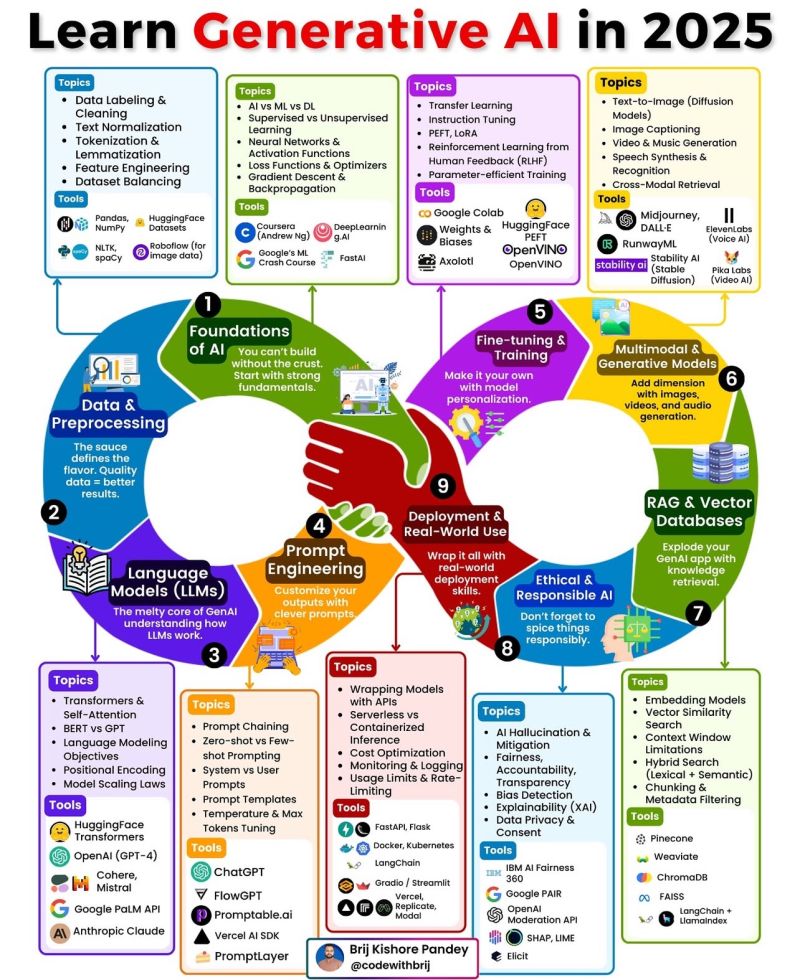In 2025, Generative AI is no longer a futuristic concept—it’s a transformative force across industries. Whether you’re a data scientist, developer, entrepreneur, or student, mastering generative AI is essential to stay ahead. This guide breaks down the entire learning journey step-by-step, from the foundations to deployment, based on the latest trends, tools, and technologies shaping the AI world.

1. Data & Preprocessing – The Foundation of AI Mastery
Before training any model, we must start with high-quality data. Data preprocessing is the secret sauce that ensures the effectiveness of your AI models.
Key Topics:
- Data Labeling & Cleaning
- Text Normalization
- Tokenization & Lemmatization
- Feature Engineering
- Dataset Balancing
Tools to Use:
- Pandas, NumPy for data manipulation
- HuggingFace Datasets for ready-made datasets
- NLTK, spaCy for natural language preprocessing
- Roboflow (for image data)
Well-preprocessed data leads to better model performance. The quality of your input determines the value of your output.
2. Foundations of AI – Building Your Conceptual Arsenal
Strong AI systems stand on solid theoretical ground. A thorough understanding of machine learning fundamentals is essential.
Key Topics:
- AI vs ML vs DL
- Supervised vs Unsupervised Learning
- Neural Networks & Loss Functions
- Gradient Descent & Backpropagation
Recommended Resources:
- Coursera (Andrew Ng)
- DeepLearning.AI
- Google’s ML Crash Course
- FastAI
This stage is all about building intuition—the bridge between theory and real-world applications.
3. Language Models (LLMs) – The Core of Generative AI
Language Models are at the heart of generative AI. From transformers to GPT, knowing how LLMs function is critical.
Key Topics:
- Transformers & Self-Attention
- BERT vs GPT
- Language Modeling Objectives
- Positional Encoding
- Model Scaling Laws
Powerful Tools:
- HuggingFace Transformers
- OpenAI (GPT-4)
- Google PaLM API
- Anthropic Claude
- Mistral
Language models power modern AI assistants, chatbots, translators, and more.
4. Prompt Engineering – Communicate with AI Like a Pro
Prompt engineering enables you to steer generative models with precision. It’s a skill that turns good results into great ones.
Key Topics:
- Prompt Chaining
- Zero-shot & Few-shot Prompting
- System Prompts
- Prompt Templates
- Token Tuning & Temperature Settings
Best Tools:
- ChatGPT
- FlowGPT
- Promptable.ai
- PromptLayer
- Vercel AI SDK
Prompt engineering is your secret weapon to unlock model creativity and consistency.
5. Fine-tuning & Training – Make AI Work for You
Once you understand prompts, the next step is to fine-tune pre-trained models to match your use case.
Key Topics:
- Transfer Learning
- Instruction Tuning
- PEFT, LoRA
- Reinforcement Learning from Human Feedback (RLHF)
- Parameter-efficient Training
Essential Tools:
- Google Colab
- Weights & Biases
- HuggingFace PEFT
- OpenVINO
- Axolotl
Model customization helps you scale AI for niche and enterprise-grade tasks with control.
6. Multimodal & Generative Models – Go Beyond Text
AI is no longer just about text. In 2025, generative AI can create images, videos, and even music.
Key Topics:
- Text-to-Image (Diffusion Models)
- Image Captioning
- Video & Music Generation
- Speech Generation & Recognition
- Cross-Modal Retrieval
Top Tools & Models:
- MidJourney, DALL·E
- RunwayML
- Stability AI (Stable Diffusion)
- ElevenLabs (Voice AI)
- Kaiber (Video AI)
Multimodal models offer a new creative frontier for developers, marketers, and artists alike.
7. RAG & Vector Databases – Empower Retrieval-Augmented Generation
RAG (Retrieval-Augmented Generation) boosts AI’s intelligence by combining LLMs with knowledge bases.
Key Topics:
- Embedding Models
- Vector Similarity Search
- Context Window Limitations
- Hybrid Search (Lexical + Semantic)
- Chunking & Metadata Filtering
Best Tools:
- Pinecone
- Weaviate
- ChromaDB
- FAISS
- Langchain + LlamaIndex
Using RAG, you can build chatbots that talk like ChatGPT but know everything about your business.
8. Ethical & Responsible AI – Build with Integrity
AI must be built with fairness, accountability, and transparency in mind. Ethical AI ensures long-term success and trust.
Key Topics:
- AI Hallucination & Mitigation
- Fairness & Bias Detection
- Explainability (XAI)
- Data Privacy & Consent
- AI Governance
Ethical AI Tools:
- IBM AI Fairness
- Google PAIR
- OpenAI Moderation API
- SHAP, LIME
- Elicit
Ethical AI is no longer optional. It’s a strategic and legal necessity in regulated environments.
9. Deployment & Real-World Use – Bringing AI to Life
Deployment is the final piece of the puzzle—turn your models into scalable applications.
Key Topics:
- Wrapping Models with APIs
- Serverless vs Containerized Inference
- Cost Optimization
- Monitoring & Logging
- Rate Limits & Scaling
Deployment Tools:
- FastAPI, Flask
- Docker, Kubernetes
- LangChain
- Vercel, Streamlit, Gradio
The key to success is combining engineering excellence with user-friendly interfaces.

